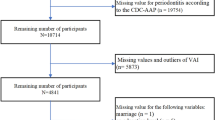Abstract
Data sources
The search strategy included both electronic and hand searches up to December 2009. The electronic search included Ovid, MEDLINE, EMBASE, LILACS and SIGLE and looked for grey literature.
Study selection
All study designs that included measures of periodontitis and body composition were eligible for inclusion, with the exception of case studies and case series.
Data extraction and synthesis
Data were extracted independently by two reviewers. Three meta-analyses were performed comparing obese and non-obese, overweight and non-overweight and overweight/obese combined compared with non-overweight/obese in relation to the associated odds of periodontitis.
Results
Thirty-three studies were included in the systematic review. Nineteen studies provided sufficient information for inclusion in meta-analyses. Meta-analyses indicated statistically significant associations between periodontitis and body mass index (BMI) category obese OR 1.81 (1.42, 2.30), overweight OR 1.27 (1.06, 1.51) and obese and overweight combined OR 2.31 (1.40, 3.26).
Conclusions
These results support an association between BMI overweight and obesity and periodontitis, although the magnitude is unclear. There is insufficient evidence to provide clinicians with guidelines on the clinical management of periodontitis in overweight and obese patients.
Similar content being viewed by others
Commentary
This systematic review is carried out at a time when there are serious concerns relating to the prevalence of obesity; it is now a worldwide public health problem. It has implications for the planning and delivery of dental services and the management of individual dental patients.1
A number of specific medical conditions are associated with obesity and this study considers whether there is an association between overweight and obese adults and periodontitis. The researchers clearly articulated a principle and an additional aim and defined the study population. Both obesity and periodontitis are ambitious topics on which to conduct a systematic review due to the extent of the literature available, especially as the majority of the data were from study designs low in the hierarchy of evidence.
The strengths of the study include a comprehensive literature review to investigate the best evidence available based on predefined criteria. The authors acknowledged that despite their literature search further data could lie in publications not specifically related to obesity/overweight and periodontitis but in studies considering other co-morbidities.
The Newcastle-Ottawa Quality Assessment Scale was used to assess studies. However, it would have been beneficial for the reader to have had access to the individual study grading in order to make their own assessment of the quality of the studies.
Meta-analyses were used to summarise the results of nineteen independent studies. Due to the level of heterogeneity in this review pooled estimates of the odds ratios were calculated using random effects models. The three forest plots showed an association between obese/overweight adults and periodontitis, with obese people being more likely to have periodontitis.
Interestingly, the review chose to group all types of study together, based on the outcome reported and similar BMI groupings and did not give extra weighting to the cohort studies. Whilst the authors acknowledge that assumptions had been made, further discussion as to this decision would have given greater clarity to the reader.
There was a detailed discussion focusing on the common biological mediators for periodontitis and obesity but then the authors acknowledged that other factors could also be associated with both obesity/overweight and/or periodontitis.
The review concluded that ‘there is insufficient evidence to provide specific guidance to clinicians’, so can this review help change the practice of the dental workforce and encourage the workforce to discuss their patients' oral health and general health? Screening and brief interventions in the dental practice, focusing on alcohol and smoking, are being promoted and there is a willingness from the dental workforce to engage with health promotion and prevention programmes.2 A number of challenges still need to be overcome to make it common practice, and discussing the patient's weight in the dental setting might be one step too far. Perhaps the dental workforce should concentrate on giving dietary advice, a topic they are more familiar with and confident to deliver?
The British Dental Association states in the Oral Health Inequalities Policy that ‘improving oral health should be part of the government's wider public health strategy across the UK, as many of the key factors of poor oral health are key risk factors for other conditions’.3
In summary, this review is valuable and raises the profile of oral health in a medical journal. The dental team should be encouraged to act as ambassadors for the wider public health agenda using the common risks approach.
Practice point
-
The dental team is ideally placed to engage with the ‘well’ population and deliver key messages to improve oral health and general health.
-
The dental team should be aware of health and safety issues relating to treating obese and overweight people eg the maximum lifting weight of their dental chairs, manual handling and complying with the Equality Act (2010).
References
Reilly D, Boyle CA, Craig DC . Obesity and dentistry: a growing problem. Br Dent J 2009; 207: 171–175.
Dyer TA, Robinson PG . General health promotion in general dental practice – the involvement of the dental team Part 2: A qualitative and quantitative investigation of the views of practice principals in South Yorkshire. Br Dent J 2006; 201: 45–51.
British Dental Association. The British Dental Association oral health inequalities policy. London: British Dental Association, 2009.
Author information
Authors and Affiliations
Additional information
Address for correspondence: Jean Suvan, Unit of Periodontology, University College London (UCL). Eastman Dental Institute, London, UK. E-mail: j.suvan@eastman.ucl.ac.uk
Suvan J, D'Aiuto F, Moles DR, Petrie A, Donos N. Association between overweight/obesity and periodontitis in adults. A systematic review. Obes Rev 2011; 12: e381–404.
Rights and permissions
About this article
Cite this article
O'Keefe, E. Periodontitis associated with obesity although the magnitude of association unclear. Evid Based Dent 13, 12–13 (2012). https://doi.org/10.1038/sj.ebd.6400839
Published:
Issue Date:
DOI: https://doi.org/10.1038/sj.ebd.6400839



